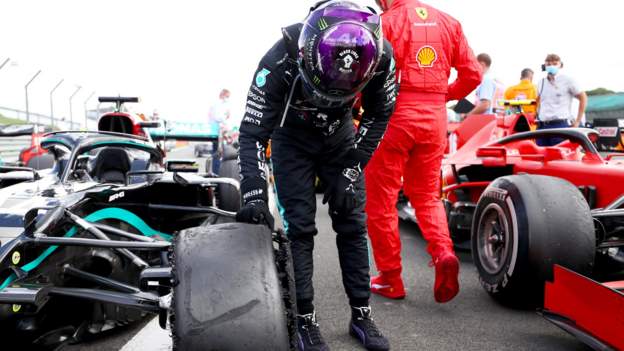
Formula 1 tyre supplier Pirelli says the failures suffered by three cars near the end of the British Grand Prix were caused by “extremely long use” on a demanding circuit.
Pirelli said tyres had been stressed by teams running long stints after early pit stops under a safety car.
It said the increased speeds of the 2020 cars had also contributed.
Pirelli F1 boss Mario Isola said he believed the right-rear tyre failure that triggered Daniil Kvyat’s Alpha Tauri to crash on lap 12 was “probably caused by a slow puncture”, but he said that the tyre had been sent back the company’s base in Milan for further investigation. This was the incident that prompted the safety car that led to the early pit stops.
Pirelli is sticking with its decision to supply softer tyres for this weekend’s 70th Anniversary Grand Prix, which will also be held at Silverstone, but is stipulating increased minimum tyre pressures “to reduce the stress on the construction”.
Lewis Hamilton narrowly held on for victory in Sunday’s race after suffering a tyre failure early in the final lap, as he was heading down the Wellington Straight after Turn Five, the Loop.
But his Mercedes team-mate Valtteri Bottas lost second place with his failure two laps earlier, and Sainz dropped out of fifth place with his on the penultimate lap.
Hamilton said after the race that Mercedes had been told by Pirelli that the team “could do almost a whole race distance with it but [I don’t know] whether or not that’s at the pace we were going”.
Pirelli said the events of the race led to “the most challenging operating conditions for tyres”.
Its statement added: “The second safety-car period prompted nearly all the teams to bring forward their planned pit stop and so carry out a particularly long final stint: around 40 laps, which is more than three-quarters the total race length on one of the most demanding tracks of the calendar.
“Combined with the notably increased pace of the 2020 F1 cars (pole position was 1.2 seconds faster compared to 2019) this made the final laps of the British Grand Prix especially tough, as a consequence of the biggest forces ever seen on tyres generated by the fastest F1 cars in history.”
It added that these factors “placed the left-front tyre under maximum stress for a very high number of laps, with the resulting wear meaning that it was less protected from the extreme forces in play”.
